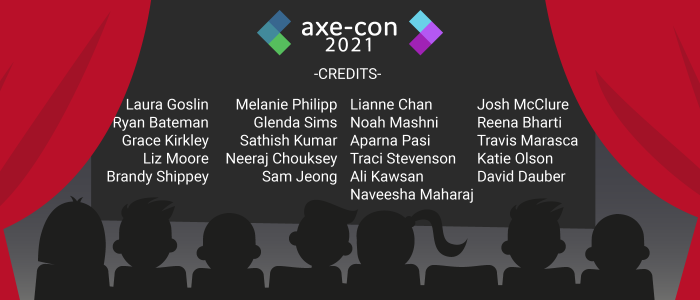Behind the scenes of axe-con: building a large, accessible conference.
We learned a lot producing axe-con this year. Here is a bit of storytelling, tools and services recommendations and other lessons learned from the show. I hope this post does a few things:
- Provides some tips on hosting your own accessible event.
- Provides some transparency into our efforts to make axe-con an accessible and welcoming place.
- Enables a continued dialog, so that axe-con can get better next year.
Background on community-powered growth
Every day since August 31st 2020, my colleagues and I have been watching in awe of the axe-con registration counter. At launch in September we hit 2k and soon thereafter added another 1k each month leading into the holidays. Like most orgs in the B2B space, we expected a dip in interest and began prepping to try and rally our marketing efforts in January 2021. But… interest in axe-con kept building and building, exceeding 5k registrations before the year end.
Feeling a renewed sense of purpose after ridding ourselves of the trash heap that was 2020, we asked a bunch of the axe-con Speakers to record a short promo video. We asked them to promote their own talk, mention a few fun items about themselves and to promote someone else’s talk at the start of the new year. This is the precise moment axe-con went from “respectable digital accessibility conference” to “community powered digital accessibility juggernaut.” The wonderful speakers of axe-con assembled beautiful, authentic, funny and passionate 30-second videos that helped axe-con break through the traditional Deque-orbit into an entirely new subset of people. That burst of new interest started a word-of-mouth referral effort unlike any I’ve seen. So much so, that one organization (who will remain nameless) brought as many as 305 employees to the conference alone!
We continued watching that registration counter, 2k new folks a month piled on and spiked even more in the few weeks prior to go-live. Emotions at this point are best described internally as panicked, nervous, overjoyed and optimistic, but more than anything, grateful.
The passion y’all have in the accessibility community is infectious and unmatched by any other.
Axe-con wouldn’t be what it is today without you.
So, how did we deliver the conference?
First, let’s outline a few requirements we had for the live conference.
- Fully virtual conference delivered via a WCAG 2.0 AA conformant platform.
- Chat, Q&A and Polling features.
- A modern look and feel
- Scale to support ~6k simultaneous users
- Zoom-powered backend for speakers and moderators.
- Accessible PDFs of every presentation posted in advance of the live session.
- Support to host 4 simultaneous topic tracks.
- Support for live, human-generated captions.
- Support for ASL.
- Some sort of virtual fun.
- A code of conduct.
With these requirements in mind, we began planning.
Finding an accessible event platform with Chat and Q&A
We knew that finding an accessible platform to deliver the conference was going to be our biggest challenge, so we started shopping very early for this. In total, we looked at 8-10 various platforms. The vast majority were very easy to dismiss after a simple automated check against their “demo” event sites and an inquiry about the process those vendors follow to maintain Section 508/ADA/WCAG conformance. Just a few of the sales reps we spoke with knew what any of these keywords were, and all of them that did, made very, very false claims about the actual state of accessibility of the platforms they represent. These had critical blockers in place that would require a deeper partnership to help get addressed.
Tip: Trust, but verify every accessibility claim. We were handed some prepared fact sheets about how accessible certain platforms are only to find out later that the current version of their platform had fallen far from conformance of any kind.
After we narrowed down our options to about two, we started filing accessibility bugs for their demo environments. This process is key in determining what sort of culture really exists behind the scenes. Which vendor will need the most hand-holding? Which will object to the “added cost” of us telling them to make their platform legally compliant? I can’t tell you how many times we’ve shopped for software, only to end on bad negotiating terms because the software provided wants to charge US to help THEM make their software accessible enough to meet our demand. Woof.
Anyway, back on track. We found that our friends, Vario (who we’ve partnered with in the past for AV needs at conferences in the “before-times”), easily had the best culture we encountered to: take our feedback, act quickly on it, and not charge us added professional services fees in the process. Prior to signing a contract, the work to audit and remediate the platform was already underway. Using some of the brilliant a11y expert minds at Deque, we ran some automated and manual tests against a version of the platform we wanted, identified a number of issues, stack-ranked the critical and serious issues and went to work collaboratively to address them.
One scary aspect we knew was unavoidable was selecting a platform provider who relied on 3rd-party applications as a part of their platform ecosystem. In this case, Slido was providing the chat, Q&A and polling function. Just like we did with Vario for the core platform, we audited the Slido functions and provided a list of required fixes prior to signing a contract. While I can’t say we got all the bugs fixed in time (we had to cut Polling for this reason), the Slido team did a great job prioritizing our fixes. Hat tip to Vario, as well, in helping to provide a united front as we approached Slido Support to get the bugs we found addressed in a timely manner. Remember, we aren’t even directly Slido customers in this use case and Deque certainly doesn’t have Fortune 100 buying power to throw around.
Tip: When vendor shopping, inquire for a list of all associated third-party apps. Inform the vendor that the accessibility of those apps bear equal weight on your purchasing decision.
Modern look and feel
Having impersonalized avatars, fake conference audio chatter and completely hidden navigation elements is not a substitute for real events. Stop using these. Make a virtual event a good virtual event and not a pathetic recreation of a physical one. Nobody wants this. Seriously.
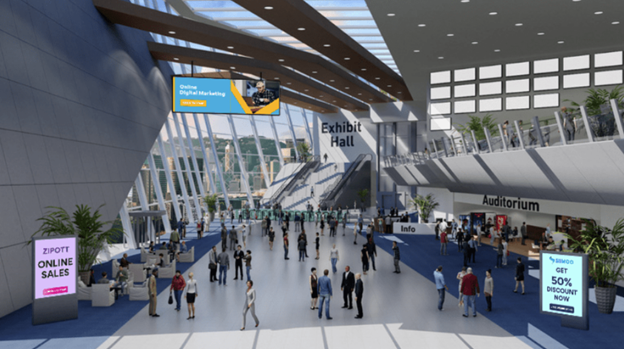
The impact of scale on the axe-con experience
We’ve been fortunate enough to run some pretty successful webinars in the past. Some surpassing 2,000 concurrent users. What did we learn from those? The local Zoom app can’t handle it. Thousands of chat messages and questions flowing in at once causes app instability for moderators and presenters, making the app borderline unusable. As much as we love Zoom and its accessibility, it could not meet our needs for the scale of this event. Also, jumping across 81 separate Zoom meetings isn’t anyone’s idea of a good time.
As registrations continued to climb past 5k, 10k, 15k, we knew we made the right decision to offer an alternative front-end experience for viewers to receive the content. The front-end was a Vimeo-powered live stream embedded within our event platform. On the back-end, we were piping various Zoom feeds from Speakers and Moderators through vMix and into Vimeo. This provided us with a scalable infrastructure to potentially tens of thousands of simultaneous viewers. This also provided a familiar video player interface for viewers with a wide range of ability and experience levels.
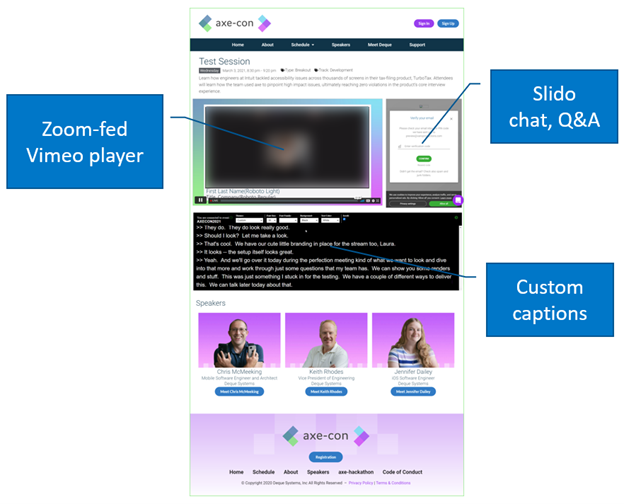
Another layer of complexity introduced by putting on a conference of this scale was providing support for many variations of presentation formats. Across 82 sessions, we had to account for about 10 different speaker presentation formats. Through each, we had to consider whether shared screen and ASL actions were large enough to be legible.
Here are the known presentation formats we had to test for:
- 1 speaker, 1 moderator, 1 ASL
- 1 speaker, 1 moderator, 1 screenshare
- 1 speaker, 1 moderator, 1 ASL, 1 screenshare
- 2 speakers, 1 moderator
- 2 speakers, 1 moderator, 1 ASL
- 2 speakers, 1 moderator, 1 ASL, 1 screenshare
- 3 speakers, 1 moderator
- 3 speakers, 1 moderator, 1 screenshare
- 4 speakers, 1 moderator
- 4 speakers, 1 moderator, 1 screenshare
In an effort to ensure the video contents were easily visible, we mistakenly pushed the captions down out of the common viewport without the ability to easily pop it out into a customizable window. This is an improvement we hope to make next year.
Tip: Test drive the production viewing experience with accessibility features in place.
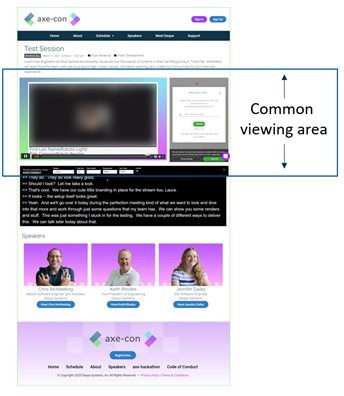
Some comments about Captions and ASL
I’m proud of the priority, planning and attention we were able to provide for Captions and ASL this year. Here’s why: streaming at scale while passing several Zoom feeds through a live-mixing platform and into a webpage introduces a 22-second delay between when something is presented and when viewers see it. To deliver timely captions, live captioner watches and transcribes from the user interface 22 seconds in the past, while speakers, moderators and ASL press on. This time difference took a fair bit of troubleshooting and testing to ensure the caption timing was accurate. What we didn’t plan for, however, was the unreliability of humans.
Despite our testing and planning efforts, captions and ASL were the unanimous complaint about axe-con this year. Why? Two reasons:
- The way we delivered captions and ASL was not flexible enough
- Our caption and ASL staff showed up late and sometimes not at all
Automated captions (affectionately referred to as “craptions” by many) was an approach we’ve tried hard to avoid. It’s important to us that the captions we deliver are as accurate as possible. For this reason, we worked with a large caption vendor to ensure a human was transcribing every single session at axe-con in real time. But, for 16 of the 82 sessions, they showed up late, encountered technical difficulties or didn’t show up at all. For ASL interpretation service, it’s common practice to have back-up staff in place. When one interpreter gets tired, another subs into their place. At axe-con, the very first interpreter for the opening keynote had a family emergency, causing them to backout minutes before our scheduled go-live, resulting in us having to scramble and move the schedule forward for the remaining ASL staff. This transition had a snowball effect that was not handled well. What would we do differently next time? Ensure backup people and alternative solutions are available if needed.
Tip: Have automated captions ready to deploy as a backup and get a written disaster recovery plan from the ASL service provider.
Accessible, Virtual Fun
We’re all pining for some human contact again aren’t we? Alas, here we are with about 82 hours of video for you to consume in 48 hours!? Look, we knew it was going to be super difficult to replace the magic that happens when you otherwise get to have hallway conversations, get a drink at a bar or simply sit back and watch or listen to excited conference chatter. While we did not attempt this year to address most of those needs, we did try to offer some entertaining and accessible virtual sessions.
The first night of the conference, we offered accessible Trivia. This option is a little trickier since RSVPs are required to make it work. For that reason, we had a limited number of seats available and it filled up in just a matter of minutes. We worked with our friends at Sporkle to make only minor adjustments to their typical Virtual Trivia offer to make it more accessible. Here’s how it works:
- Get 100 people to join a zoom with the breakout feature available.
- The event host outlines rules, which includes ensuring a sighted team captain is available for each team. Use a captioning service to serve the main room.
- Host asks a question, then sends everyone to their team breakout room in zoom. Ensure the host knows how to present an accessible visual and can clearly and slowly describe the contents of the question.
- Teammates discuss the answer and a point value. Use zoom chat and/or auto-captions here. The captain relays that answer and point value back to the event host. Sporkle’s app needs improvement, hence the need for a sighted user to relay team answers.
- Time expires and the Host brings everyone back into the main zoom session to reveal the answer.
- Repeat the above for whichever number of questions that time allows. Then, announce a winner.

The second night, we offered a Virtual Cocktail Course. This was more of a webinar-style presentation since we had thousands of potential guests, but you could easily run it as a smaller networking session for around ten people with everyone’s video and audio enabled for two-way chat. To ensure this event was accessible, we captioned the event and did some pre-work with Jason to make sure his actions were appropriately described. Using zoom and preparing and sharing the recipe in advance is key as well. In the “spirit” of inclusivity, it’s best to provide a recipe that works with, or without alcohol.
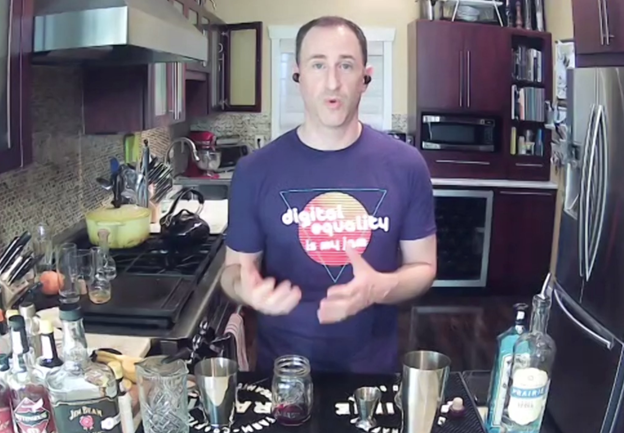
Accessible presentations
Collecting 82 presentations from 104 speakers, weeks before their scheduled time to present is a daunting task, but an important one. In fact, we’re still missing a few. But our deadline to get final presentations was February 15th, a full three weeks before the first day of the conference because remediating presentations takes time. Even a conference full of accessibility experts speaking about digital accessibility, still requires accessibility reviews and fixes.
Why go to this length? Everyone wants the slides anyway. Get it over with already. Also, posting the slides in advance of the live presentation gives folks who might need the extra time to prepare. If captions fail, presenters bail or technology breaks, users will be guaranteed one path to content.
Here’s how we made slides accessible at axe-con this year: We worked with our friends at Apex CoVantage. They do great PDF remediation work which doesn’t grow on trees. We prefer to convert the various forms of presentations we get to PDF because not everyone has access to PowerPoint, Slides, Keynote or Prezi. As soon as we got each presentation, we passed to them for clean-up, then posted to each session page, around 3 days before the live event.
Enforcing a Code of Conduct and inclusive event culture
Hosting a safe and inclusive event was a high priority for us. The need for a documented code of conduct is something we’ve heard a lot of and unfortunately seen much less of in real life. The decision to implement one was easy. If you registered to interact with axe-con, you agreed to this code of conduct. We ensured that a formal complaint process was in place and that session moderators knew what to do if problems arose.
When evaluating a virtual event platform, make sure you have a process in place to communicate to, investigate and boot violators in real-time. Ours was fairly simple. We used a group-text chain, shared Slack channel and held training for the axe-con moderators in advance. Were an individual to act in a way that violated the code of conduct, our team was equipped with the tools to be able to handle the situation swiftly and with minimal interruption.
Summary
I hope this long and rambling post provided some background on the work effort that went into making the inaugural axe-con as accessible as possible. We learned a ton and hope that you too can benefit from our experience documented here. We look forward to continuing to improve next year and want to thank everyone who helped make this year a success.
If you have any questions or comments to help us improve, feel free to comment below.
Special thanks to: Laura Goslin, Grace Kirkley, Liz Moore, Brandy Shippey, Melanie Philipp, Glenda Sims, Sathish Kumar, Neeraj Chouksey, Sam Jeong, Josh McClure, Reena Bharti, Travis Marasca, Katie Olson, David Dauber, Lianne Chan, Noah Mashni, Aparna Pasi, Traci Stevenson, Ali Kawsan and Naveesha Maharaj.
